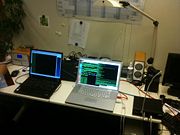Example of live re-broadcasting on DAB of many Internet radio stations
Contents |
General procedure
It is advised to use two linux PC, one attached to the USRP doing the OFDM modulation (CPU intensive); the second receiving the streams from Internet, encoding them, making the DAB multiplex and sending the multiplex stream to the first PC.
On the modulation PC:
- Have CRC MMBtools installed from the CD, USRP attached to the USB
- Make a FIFO for the ETI stream
- Start a netcat listening on a free TCP port and redirect it to the FIFO
- Start the modulator process with the FIFO as input
On the multiplexer PC:
- Have CRC MMBtools installed from the CD or download and compile CRC-DabMux multiplexer from the sources.
- Create a FIFO for each station
- For each station: Receive stream using mpg123, encode it live in MPEG Layer II using toolame and send it to the FIFO
- Start MUX process with every FIFO as input and use a pipe into a Netcat process sending to the TCP port you defined on the modulation PC.
- That's it (if everything configured properly), program can be received on any DAB receiver.
It is possible to make both processes on the same machine if CPU is powerful enough.
Commands on modulation PC
Creation of FIFO:
mkfifo etistream.fifo
Listening on TCP port 1234:
netcat -l 1234 >etistream.fifo
OFDM Modulation (CRC-DabMod) and output to USRP on channel 12C (CRC-Dwap.py). See Band 3 Channels for frequencies:
CRC-DabMod etistream.fifo -f -g1 -r 3200000 |CRC-Dwap.py -r3200000 -f 227360000 -u
Commands on multiplexer PC
For each station
Creation of FIFO
mkfifo maxxima.fifo
Internet stream reception using mpg123, resampling at 48kHz and encoding in MPEG Layer II at 128kbps with 4 bytes of PAD using toolame, output to the FIFO
mpg123 -r 48000 -s http://maxxima.mine.nu:8000 |toolame -s 48 -D 4 -b 128 /dev/stdin ./maxxima.fifo
Creation of the multiplex
Multiplexing (CRC-DabMux) Declaration of each subchannel (-A) and ID (-i) and protection mode (-p); then description of each service, label (-L) and corresponding service component (-C) attached to a specific ID (-i); output of the mux to target modulator PC IP (in this example 192.168.10.10) using TCP
CRC-DabMux -A ./maxxima.fifo -b 128 -i 1 -p 3 \ -A ./lemixx.fifo -b 128 -i 2 -p 3 \ -A ./banane.fifo -b 128 -i 3 -p 3 \ -A ./meyrin.fifo -b 128 -i 4 -p 3 \ -A ./rom.fifo -i 5 -p 3 \ -S -L "Maxxima" -C -i1 \ -S -L "LeMixx" -C -i2 \ -S -L "Banane" -C -i3 \ -S -L "MeyrinFM" -C -i4 \ -S -L "RomRadio" -C -i5 \ -O fifo:///dev/stdout |netcat 192.168.10.10 1234
Multiplexing/modulation on one machine
For having both processes on the same machine, it is the same but without netcat commands:
CRC-DabMux -A ./maxxima.fifo -b 128 -i 1 -p 3 \ -A ./lemixx.fifo -b 128 -i 2 -p 3 \ -A ./banane.fifo -b 128 -i 3 -p 3 \ -A ./meyrin.fifo -b 128 -i 4 -p 3 \ -A ./rom.fifo -i 5 -p 3 \ -S -L "Maxxima" -C -i1 \ -S -L "LeMixx" -C -i2 \ -S -L "Banane" -C -i3 \ -S -L "MeyrinFM" -C -i4 \ -S -L "RomRadio" -C -i5 \ -O fifo:///dev/stdout | \ CRC-DabMod -f -g1 -r 3200000 |\ CRC-Dwap.py -r3200000 -f 227360000 -u
Notes
- Modulation is the most CPU intensive, nothing else should be made on modulation PC
- Multiplexer can handle the loss of a station (for example if FIFO is broken), however it will keep the station on air and mute the audio waiting for it to return
